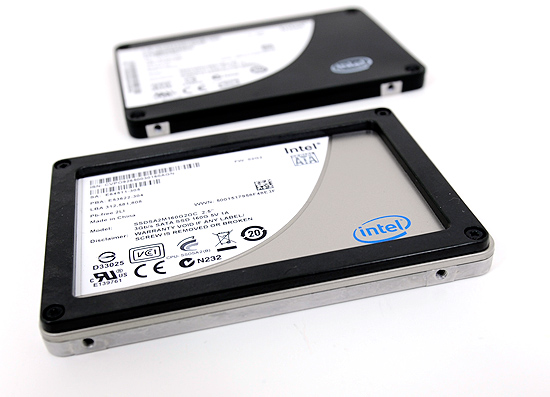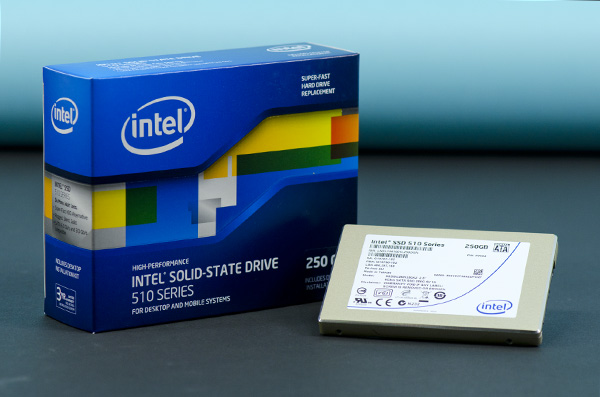The Intel SSD 510 Review
by Anand Lal Shimpi on March 2, 2011 1:23 AM EST- Posted in
- IT Computing
- Storage
- SSDs
- Intel
- Intel SSD 510
The X25-M was a tremendous first attempt by Intel to get into the SSD market. In our review of the SSD I wrote that Intel just Conroe’d the SSD market, and if it weren’t for the pesky 80MB/s sequential write speed limitation the X25-M would’ve been given the title: World’s Fastest Drive.

Its successor, the X25-M G2, was a mild update that brought prices down through the use of 34nm NAND. Remember that Intel is also 49% owner of the IMFT joint venture and as a result can be quite competitive on NAND pricing (and quite early to adopt new NAND technologies).

Intel’s goal all along was to drive down the cost of SSDs. Looking at the history of MSRPs with the X25-M (not to mention the M, which stood for Mainstream in the product name) this shouldn’t come as a surprise:
| Intel X25-M Pricing History | |||||
| 2008 | 2009 | ||||
| 40GB | - | $125 | |||
| 80GB | $595 | $225 | |||
| 160GB | $1000+ | $440 | |||
The third generation X25-M was to drive down costs even further, this time thanks to Intel’s 25nm NAND. You’d be able to get twice the capacity at the same price point as the X25-M G2. The value drive would be an 80GB offering, the mainstream drive would be 160GB and the high end drive would be 320GB.
The drive would offer higher performance. The controller was to be completely redesigned, with the “oversight” that limited sequential write speed to only 100MB/s corrected entirely. In addition, the third generation Intel SSD would add full disk encryption - making it even better suited for enterprise customers. Going after the enterprise market was Intel’s plan to really make money on SSDs in the long run. Instead of just selling corporations a CPU, chipset and wireless controller in a notebook, there would be an SSD on top of all of that. Perhaps eventually even have some security software courtesy of McAfee.
The third generation X25-M was originally due out in the middle of 2010. As is usually the case with schedules, the “G3” slipped. The middle of the year became the end of the year and the end of the year became Q1 2011.
To make matters worse, the specifications Intel was talking about for its third generation drive/controller weren’t all that competitive. We published the details last year knowing that the competition would do better. Intel’s redesigned controller was late and underperforming. Internally, Intel knew it had a problem.
Intel aimed for the majority of the market with the X25-M, it had set its sights on lowering cost, but it left the high performance enthusiast market entirely uncared for. A void that SandForce filled quite nicely with its unique brand of controllers.
With a hole in the roadmap and an unwillingness to cede complete control of the high end market to SandForce, Intel did the unthinkable: developed a new SSD based on a competing controller technology.











128 Comments
View All Comments
Anand Lal Shimpi - Wednesday, March 2, 2011 - link
Correct me if I'm wrong, but I believe everything regarding the 25nm issue has been resolved? OCZ has initiated an exchange program and is covering all associated costs for users that were affected.I'm still curious to look into the behavior of 25nm NAND however by the time I got back from MWC it looks like the bulk of what needed to happen regarding the 25nm issue already happened.
Is there a remaining aspect of the issue that hasn't been addressed that you'd like me to pursue?
Take care,
Anand
semo - Wednesday, March 2, 2011 - link
Hi Anand,Thanks for replying. Just to be clear, what I've been expecting is for you to write a news item or an article about OCZ and 25nm SSDs. It seems you thought I was asking for you fix the problem (it is not your problem and it isn't you who was supposed to fix it).
I still don't understand why all the review sites were silent even after the OCZ 25nm drives hit retail. Was I the only one excited about the new NAND flash tech, and itching to read an in depth review/analysis. Some time passed and some people started complaining that their 25nm V2s were somewhat slower than what reviews (and the packaging) were promising…still no in depth look at 25nm tech at that point.
The jmicron issue was resolved eventually as well but there were a lot of articles written about it.
I’m still stumped as to how hard it is to find a proper review about the 1st ever consumer 25nm SSD to hit retail (the OCZ V2).
m.amitava - Wednesday, March 2, 2011 - link
I am sure Anand has quite a lot of pull with OCZ and I believe users who have been stranded with 25nm drives will thank him for investing his time in sorting out the issue rather than writing on it....would like to hear your POV though Anand, so far you haven't given us your take on it....
FunBunny2 - Thursday, March 3, 2011 - link
-- Is there a remaining aspect of the issue that hasn't been addressed that you'd like me to pursue?Absolutely!!! Not so much the OCZ nonsense, but rather the impact we can expect on SSD acceptance and viability with 25nm parts. IIRC, IMFT NAND at 25nm has/will have ECC on die to deal with some of the issue.
What's not clear is whether an SSD can be built at 25nm that ends up being as "good" as one at 32/34nm at the same price point. We may have hit a corner case in Moore's Law: the reduction in price at 25nm may not be sufficient to overcome both the erasure and electrical issues which present at 25nm. The OCZ fix was to replace larger die with smaller die to get back channels. That's gotta hurt the profit equation. And this doesn't fix the erasure issue.
In other words, there's a whole lot to be delved into with regard to 25nm impact on SSD. A whole lot.
semo - Friday, March 4, 2011 - link
"Correct me if I'm wrong, but I believe everything regarding the 25nm issue has been resolved?"I've just done a quick search on newegg for a Vertex 2 and I still can't figure out at a glance which are the nerfed 25nm drives and which aren't. So the bait-and-switch games is still on as far as I can tell.
Anand Lal Shimpi - Wednesday, March 2, 2011 - link
It really boils down to the performance vs. reliability debate. The Vertex 3 is overall a faster drive (assuming you're not doing much in the way of incompressible writes), however it's unclear how much OCZ and SF have improved their reliability testing and validation. If the 510 is close enough in performance and can boast the same sort of reliability that the original X25-M did, then it may be a viable alternative for some users who aren't as interested in absolute performance but want a product that has gone through Intel's validation/testing.With the X25-M the performance gap was too great to really value the drive over the SF-1200 based offerings. The 510 is much more competitive, although our recommendation for pure performance is still obviously the Vertex 3.
As I mentioned in the conclusion, if OCZ can ramp and ship the Vertex 3 with a better reliability track record than the Vertex 2 (not that the latter was bad, it just wasn't quite as good as the X25-M) then this becomes a non-issue. The way I see it is this: the 510 pressures OCZ to work on validation and QA testing, while the Vertex 3 forces Intel to take performance much more seriously. Both are very important to have in the market.
Take care,
Anand
lyeoh - Wednesday, March 2, 2011 - link
Hi Anand, have you noticed any issues with hibernate for SSDs? Being able to hibernate is rather important for many mobile users.There are some people complaining that hibernate stopped working when they switched to their SSD drive, whereas others say they don't have probs.
As for reliability, how much more reliable are Intel really anyway? They did have problems with their previous drives too.
epicsnackus - Wednesday, March 2, 2011 - link
I have hibernated my laptop with Intel G2 160GB drive every day for more than a year, with no issuejimhsu - Wednesday, March 2, 2011 - link
I do have an issue with sleep though on an Intel SSD. On resume after sleep, the drive errors with KERNEL_NONPAGED bluescreens. Does not occur with hibernate. Any idea what is going on?aarste - Wednesday, March 2, 2011 - link
Not tried Hibernate, but sleep is working fine on my Intel X-25M 80GB (I put the PC to sleep every night), so the BSOD may be something else entirely.